MKT304: Services Marketing Essay: Comparing Air Travel to FMCG
VerifiedAdded on 2023/06/10
|7
|1487
|58
Essay
AI Summary
This essay delves into the realm of services marketing, emphasizing the critical aspects of customer satisfaction within the context of air travel, specifically using Qantas Airlines as a case study. The essay begins by defining service marketing and its evolution, highlighting the importance of customer experience due to the intangible nature of services. It then introduces the service delivery framework and the crucial role of consistency in achieving customer satisfaction. The RATER model (Reliability, Assurance, Tangibility, Empathy, and Responsiveness) is presented as an effective framework for measuring customer expectations and, consequently, satisfaction. Each element of the RATER model is discussed in relation to Qantas Airlines, illustrating how the airline strives to meet customer needs. The essay contrasts the marketing of services with that of Fast-Moving Consumer Goods (FMCG), emphasizing the differences in tangibility and the implications for marketing strategies. The conclusion reiterates the significance of the RATER model in assessing customer expectations, which ultimately translates into customer satisfaction, and the key differences between service and product marketing.

Running Head: Services Marketing
Services Marketing
Essay
Services Marketing
Essay
Paraphrase This Document
Need a fresh take? Get an instant paraphrase of this document with our AI Paraphraser
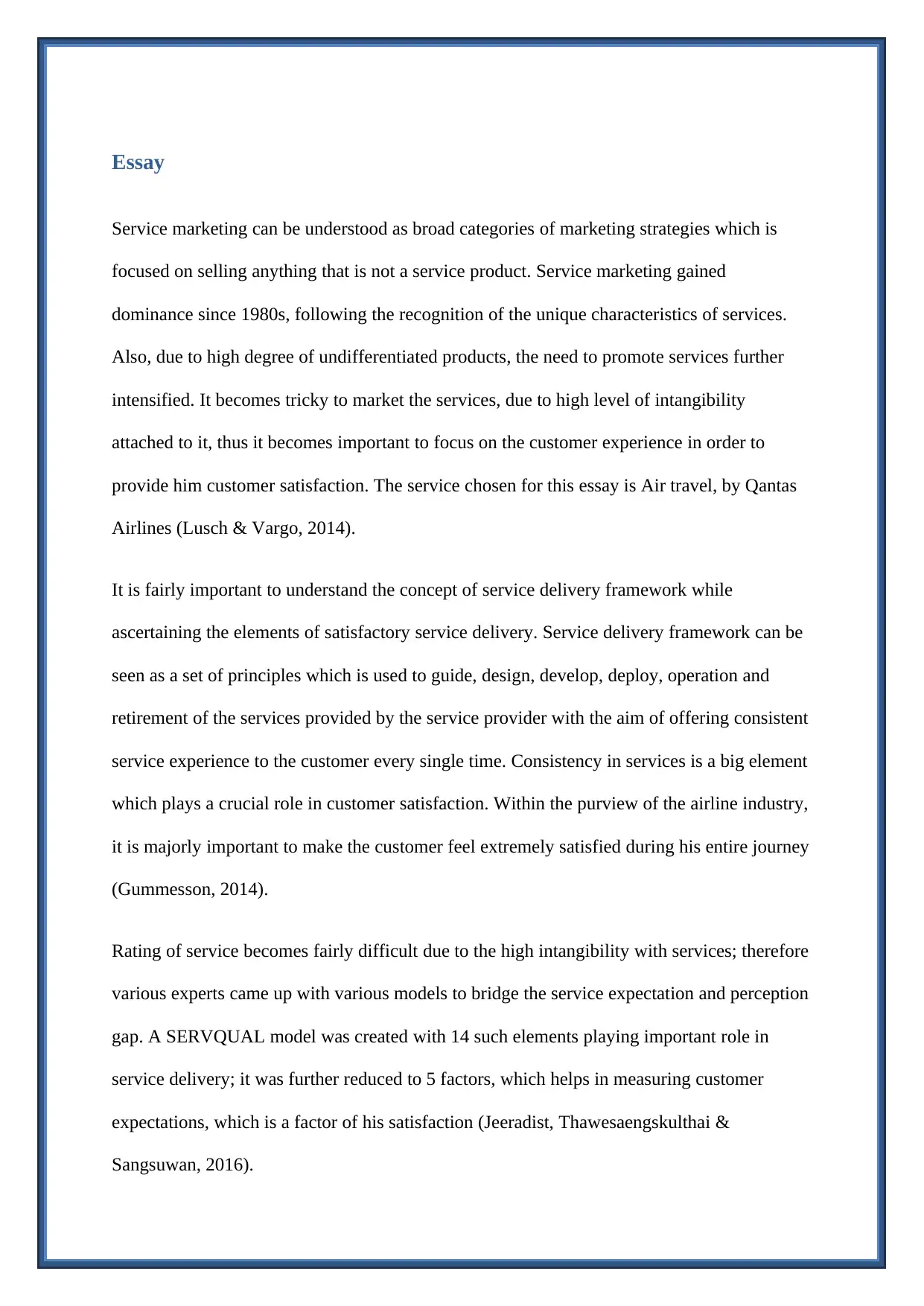
Essay
Service marketing can be understood as broad categories of marketing strategies which is
focused on selling anything that is not a service product. Service marketing gained
dominance since 1980s, following the recognition of the unique characteristics of services.
Also, due to high degree of undifferentiated products, the need to promote services further
intensified. It becomes tricky to market the services, due to high level of intangibility
attached to it, thus it becomes important to focus on the customer experience in order to
provide him customer satisfaction. The service chosen for this essay is Air travel, by Qantas
Airlines (Lusch & Vargo, 2014).
It is fairly important to understand the concept of service delivery framework while
ascertaining the elements of satisfactory service delivery. Service delivery framework can be
seen as a set of principles which is used to guide, design, develop, deploy, operation and
retirement of the services provided by the service provider with the aim of offering consistent
service experience to the customer every single time. Consistency in services is a big element
which plays a crucial role in customer satisfaction. Within the purview of the airline industry,
it is majorly important to make the customer feel extremely satisfied during his entire journey
(Gummesson, 2014).
Rating of service becomes fairly difficult due to the high intangibility with services; therefore
various experts came up with various models to bridge the service expectation and perception
gap. A SERVQUAL model was created with 14 such elements playing important role in
service delivery; it was further reduced to 5 factors, which helps in measuring customer
expectations, which is a factor of his satisfaction (Jeeradist, Thawesaengskulthai &
Sangsuwan, 2016).
Service marketing can be understood as broad categories of marketing strategies which is
focused on selling anything that is not a service product. Service marketing gained
dominance since 1980s, following the recognition of the unique characteristics of services.
Also, due to high degree of undifferentiated products, the need to promote services further
intensified. It becomes tricky to market the services, due to high level of intangibility
attached to it, thus it becomes important to focus on the customer experience in order to
provide him customer satisfaction. The service chosen for this essay is Air travel, by Qantas
Airlines (Lusch & Vargo, 2014).
It is fairly important to understand the concept of service delivery framework while
ascertaining the elements of satisfactory service delivery. Service delivery framework can be
seen as a set of principles which is used to guide, design, develop, deploy, operation and
retirement of the services provided by the service provider with the aim of offering consistent
service experience to the customer every single time. Consistency in services is a big element
which plays a crucial role in customer satisfaction. Within the purview of the airline industry,
it is majorly important to make the customer feel extremely satisfied during his entire journey
(Gummesson, 2014).
Rating of service becomes fairly difficult due to the high intangibility with services; therefore
various experts came up with various models to bridge the service expectation and perception
gap. A SERVQUAL model was created with 14 such elements playing important role in
service delivery; it was further reduced to 5 factors, which helps in measuring customer
expectations, which is a factor of his satisfaction (Jeeradist, Thawesaengskulthai &
Sangsuwan, 2016).

In my view, the RATER model is an effective framework for measuring customer
satisfaction, the elements of RATER model can be used to under the delivery of customer
satisfaction. The first element in the RATER model is reliability, it is the ability of the
organization to deliver the agreed upon services accurately and consistently on time. This is a
very crucial when it comes to ascertaining the satisfaction delivery. For instance, if a service
provider is unable to provide the agreed upon services consistently with 100% accuracy, the
customer loses faith in the service provider and makes him move to some other service
provider. In the case of Qantas Airlines, the airline has always been able to provide accurate
and consistent services, which makes him feel delighted (Wahab et. al., 2015).
Another important element in the satisfaction delivery is Assurance provide by the service
provider. Assurance can be understood as the ability of the employee to convey the
information in a convincing way to the customers. The service executive has to ensure that
the customer is convinced by the information being provided by the service executive. The
bottom-line here is that customer must be assured with the information conveyed to him, and
he can rely on the information. In case of Qantas, even in times of Flight delay, the Airline is
forthcoming to pass on the information to the customer and prevent unnecessary hassle at the
Airport (Jiang, Baxter & Wild, 2017).
One of the most important elements in the satisfaction delivery of customer is the tangibility
in the service delivery. Services are intangible, as they have to be realized in actual to
ascertain the service delivery, however, tangibility in the services can be added by virtue of
adding elements of physical aspect. For instance, in case of Qantas Airlines, the seats , the in
plane equipment, the food, the ticketing counter, uniform of the flying crew, trolleys etc. add
tangibility to the service element(Santos & Mathews, 2015).
satisfaction, the elements of RATER model can be used to under the delivery of customer
satisfaction. The first element in the RATER model is reliability, it is the ability of the
organization to deliver the agreed upon services accurately and consistently on time. This is a
very crucial when it comes to ascertaining the satisfaction delivery. For instance, if a service
provider is unable to provide the agreed upon services consistently with 100% accuracy, the
customer loses faith in the service provider and makes him move to some other service
provider. In the case of Qantas Airlines, the airline has always been able to provide accurate
and consistent services, which makes him feel delighted (Wahab et. al., 2015).
Another important element in the satisfaction delivery is Assurance provide by the service
provider. Assurance can be understood as the ability of the employee to convey the
information in a convincing way to the customers. The service executive has to ensure that
the customer is convinced by the information being provided by the service executive. The
bottom-line here is that customer must be assured with the information conveyed to him, and
he can rely on the information. In case of Qantas, even in times of Flight delay, the Airline is
forthcoming to pass on the information to the customer and prevent unnecessary hassle at the
Airport (Jiang, Baxter & Wild, 2017).
One of the most important elements in the satisfaction delivery of customer is the tangibility
in the service delivery. Services are intangible, as they have to be realized in actual to
ascertain the service delivery, however, tangibility in the services can be added by virtue of
adding elements of physical aspect. For instance, in case of Qantas Airlines, the seats , the in
plane equipment, the food, the ticketing counter, uniform of the flying crew, trolleys etc. add
tangibility to the service element(Santos & Mathews, 2015).
⊘ This is a preview!⊘
Do you want full access?
Subscribe today to unlock all pages.

Trusted by 1+ million students worldwide
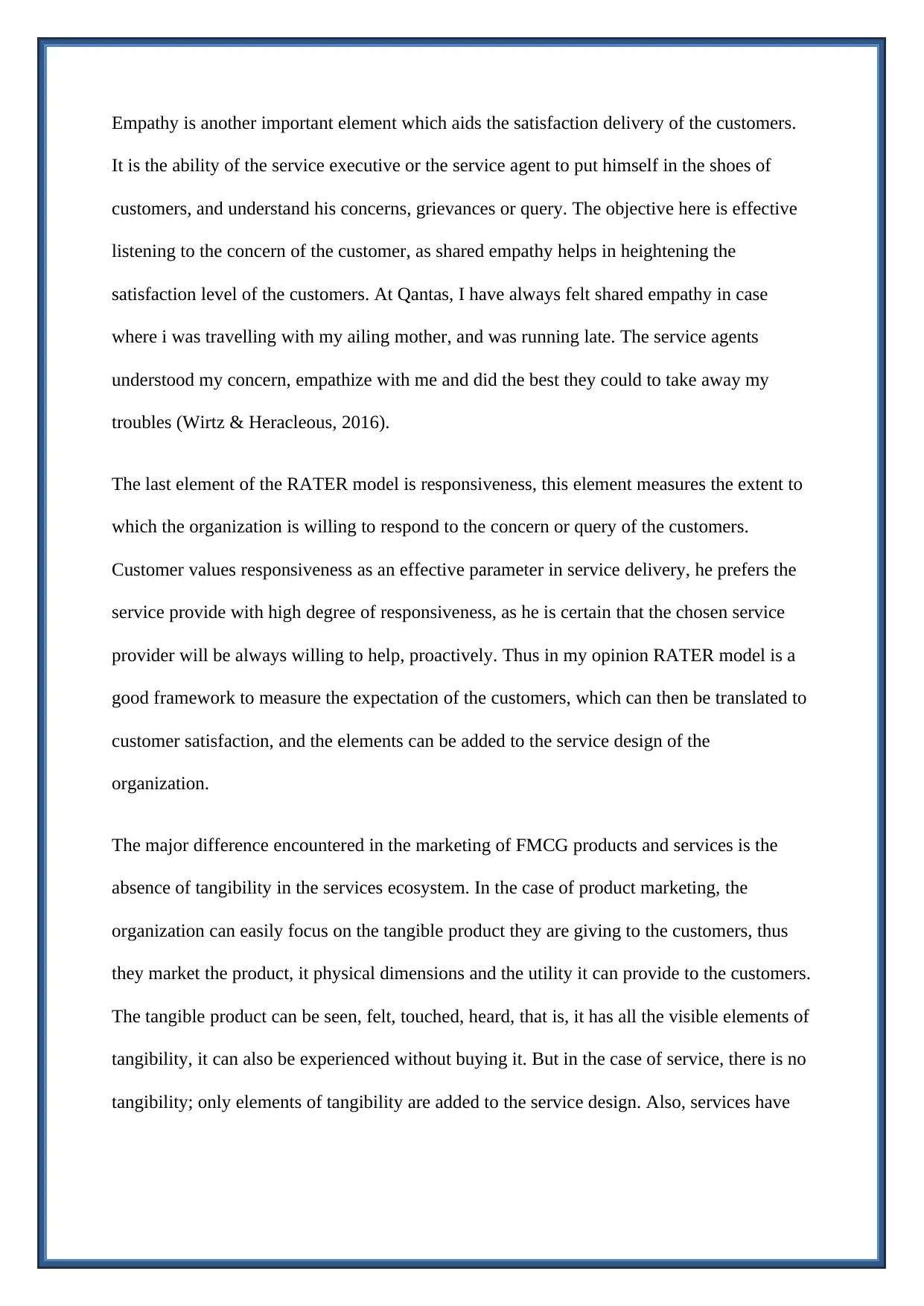
Empathy is another important element which aids the satisfaction delivery of the customers.
It is the ability of the service executive or the service agent to put himself in the shoes of
customers, and understand his concerns, grievances or query. The objective here is effective
listening to the concern of the customer, as shared empathy helps in heightening the
satisfaction level of the customers. At Qantas, I have always felt shared empathy in case
where i was travelling with my ailing mother, and was running late. The service agents
understood my concern, empathize with me and did the best they could to take away my
troubles (Wirtz & Heracleous, 2016).
The last element of the RATER model is responsiveness, this element measures the extent to
which the organization is willing to respond to the concern or query of the customers.
Customer values responsiveness as an effective parameter in service delivery, he prefers the
service provide with high degree of responsiveness, as he is certain that the chosen service
provider will be always willing to help, proactively. Thus in my opinion RATER model is a
good framework to measure the expectation of the customers, which can then be translated to
customer satisfaction, and the elements can be added to the service design of the
organization.
The major difference encountered in the marketing of FMCG products and services is the
absence of tangibility in the services ecosystem. In the case of product marketing, the
organization can easily focus on the tangible product they are giving to the customers, thus
they market the product, it physical dimensions and the utility it can provide to the customers.
The tangible product can be seen, felt, touched, heard, that is, it has all the visible elements of
tangibility, it can also be experienced without buying it. But in the case of service, there is no
tangibility; only elements of tangibility are added to the service design. Also, services have
It is the ability of the service executive or the service agent to put himself in the shoes of
customers, and understand his concerns, grievances or query. The objective here is effective
listening to the concern of the customer, as shared empathy helps in heightening the
satisfaction level of the customers. At Qantas, I have always felt shared empathy in case
where i was travelling with my ailing mother, and was running late. The service agents
understood my concern, empathize with me and did the best they could to take away my
troubles (Wirtz & Heracleous, 2016).
The last element of the RATER model is responsiveness, this element measures the extent to
which the organization is willing to respond to the concern or query of the customers.
Customer values responsiveness as an effective parameter in service delivery, he prefers the
service provide with high degree of responsiveness, as he is certain that the chosen service
provider will be always willing to help, proactively. Thus in my opinion RATER model is a
good framework to measure the expectation of the customers, which can then be translated to
customer satisfaction, and the elements can be added to the service design of the
organization.
The major difference encountered in the marketing of FMCG products and services is the
absence of tangibility in the services ecosystem. In the case of product marketing, the
organization can easily focus on the tangible product they are giving to the customers, thus
they market the product, it physical dimensions and the utility it can provide to the customers.
The tangible product can be seen, felt, touched, heard, that is, it has all the visible elements of
tangibility, it can also be experienced without buying it. But in the case of service, there is no
tangibility; only elements of tangibility are added to the service design. Also, services have
Paraphrase This Document
Need a fresh take? Get an instant paraphrase of this document with our AI Paraphraser
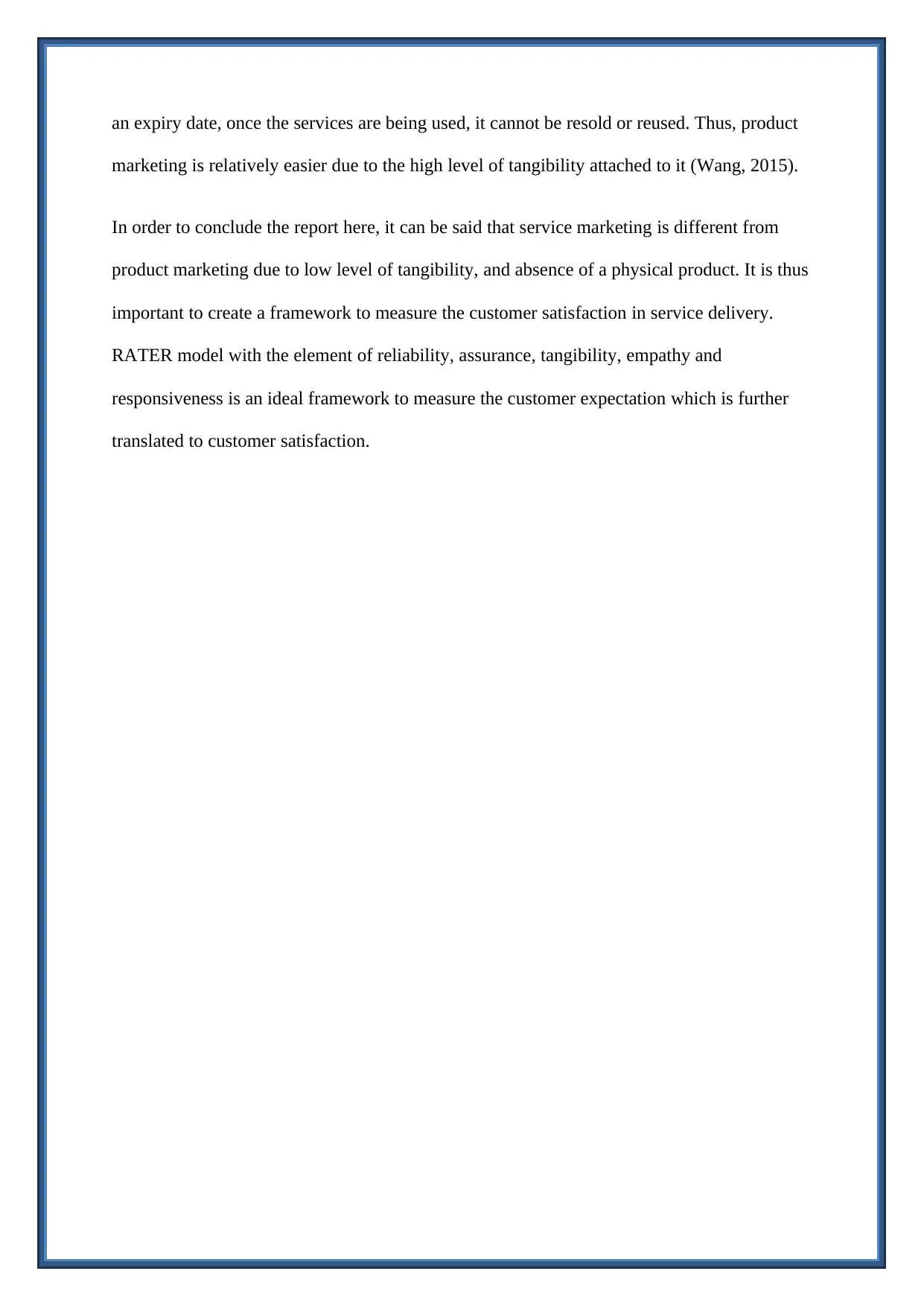
an expiry date, once the services are being used, it cannot be resold or reused. Thus, product
marketing is relatively easier due to the high level of tangibility attached to it (Wang, 2015).
In order to conclude the report here, it can be said that service marketing is different from
product marketing due to low level of tangibility, and absence of a physical product. It is thus
important to create a framework to measure the customer satisfaction in service delivery.
RATER model with the element of reliability, assurance, tangibility, empathy and
responsiveness is an ideal framework to measure the customer expectation which is further
translated to customer satisfaction.
marketing is relatively easier due to the high level of tangibility attached to it (Wang, 2015).
In order to conclude the report here, it can be said that service marketing is different from
product marketing due to low level of tangibility, and absence of a physical product. It is thus
important to create a framework to measure the customer satisfaction in service delivery.
RATER model with the element of reliability, assurance, tangibility, empathy and
responsiveness is an ideal framework to measure the customer expectation which is further
translated to customer satisfaction.
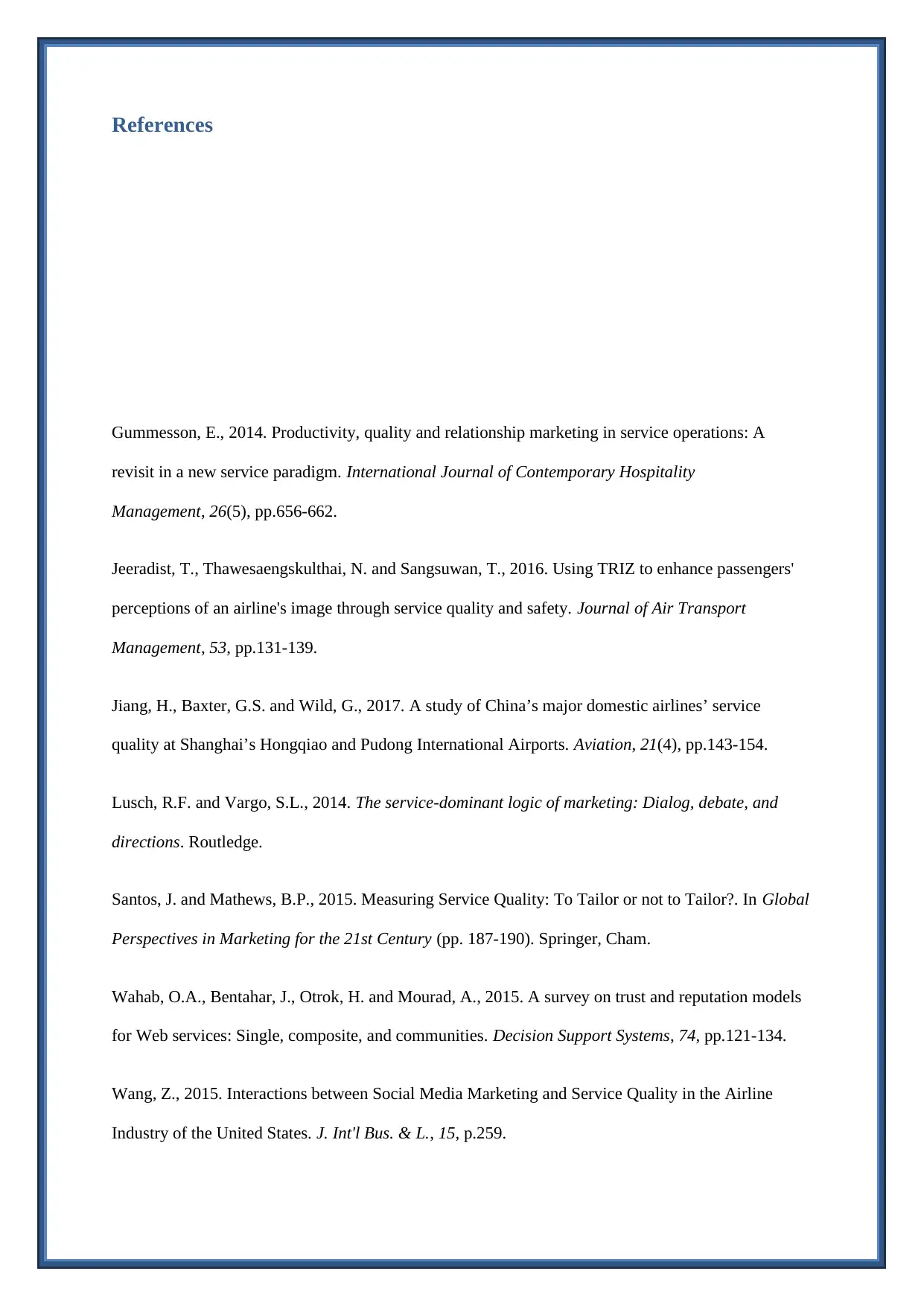
References
Gummesson, E., 2014. Productivity, quality and relationship marketing in service operations: A
revisit in a new service paradigm. International Journal of Contemporary Hospitality
Management, 26(5), pp.656-662.
Jeeradist, T., Thawesaengskulthai, N. and Sangsuwan, T., 2016. Using TRIZ to enhance passengers'
perceptions of an airline's image through service quality and safety. Journal of Air Transport
Management, 53, pp.131-139.
Jiang, H., Baxter, G.S. and Wild, G., 2017. A study of China’s major domestic airlines’ service
quality at Shanghai’s Hongqiao and Pudong International Airports. Aviation, 21(4), pp.143-154.
Lusch, R.F. and Vargo, S.L., 2014. The service-dominant logic of marketing: Dialog, debate, and
directions. Routledge.
Santos, J. and Mathews, B.P., 2015. Measuring Service Quality: To Tailor or not to Tailor?. In Global
Perspectives in Marketing for the 21st Century (pp. 187-190). Springer, Cham.
Wahab, O.A., Bentahar, J., Otrok, H. and Mourad, A., 2015. A survey on trust and reputation models
for Web services: Single, composite, and communities. Decision Support Systems, 74, pp.121-134.
Wang, Z., 2015. Interactions between Social Media Marketing and Service Quality in the Airline
Industry of the United States. J. Int'l Bus. & L., 15, p.259.
Gummesson, E., 2014. Productivity, quality and relationship marketing in service operations: A
revisit in a new service paradigm. International Journal of Contemporary Hospitality
Management, 26(5), pp.656-662.
Jeeradist, T., Thawesaengskulthai, N. and Sangsuwan, T., 2016. Using TRIZ to enhance passengers'
perceptions of an airline's image through service quality and safety. Journal of Air Transport
Management, 53, pp.131-139.
Jiang, H., Baxter, G.S. and Wild, G., 2017. A study of China’s major domestic airlines’ service
quality at Shanghai’s Hongqiao and Pudong International Airports. Aviation, 21(4), pp.143-154.
Lusch, R.F. and Vargo, S.L., 2014. The service-dominant logic of marketing: Dialog, debate, and
directions. Routledge.
Santos, J. and Mathews, B.P., 2015. Measuring Service Quality: To Tailor or not to Tailor?. In Global
Perspectives in Marketing for the 21st Century (pp. 187-190). Springer, Cham.
Wahab, O.A., Bentahar, J., Otrok, H. and Mourad, A., 2015. A survey on trust and reputation models
for Web services: Single, composite, and communities. Decision Support Systems, 74, pp.121-134.
Wang, Z., 2015. Interactions between Social Media Marketing and Service Quality in the Airline
Industry of the United States. J. Int'l Bus. & L., 15, p.259.
⊘ This is a preview!⊘
Do you want full access?
Subscribe today to unlock all pages.

Trusted by 1+ million students worldwide
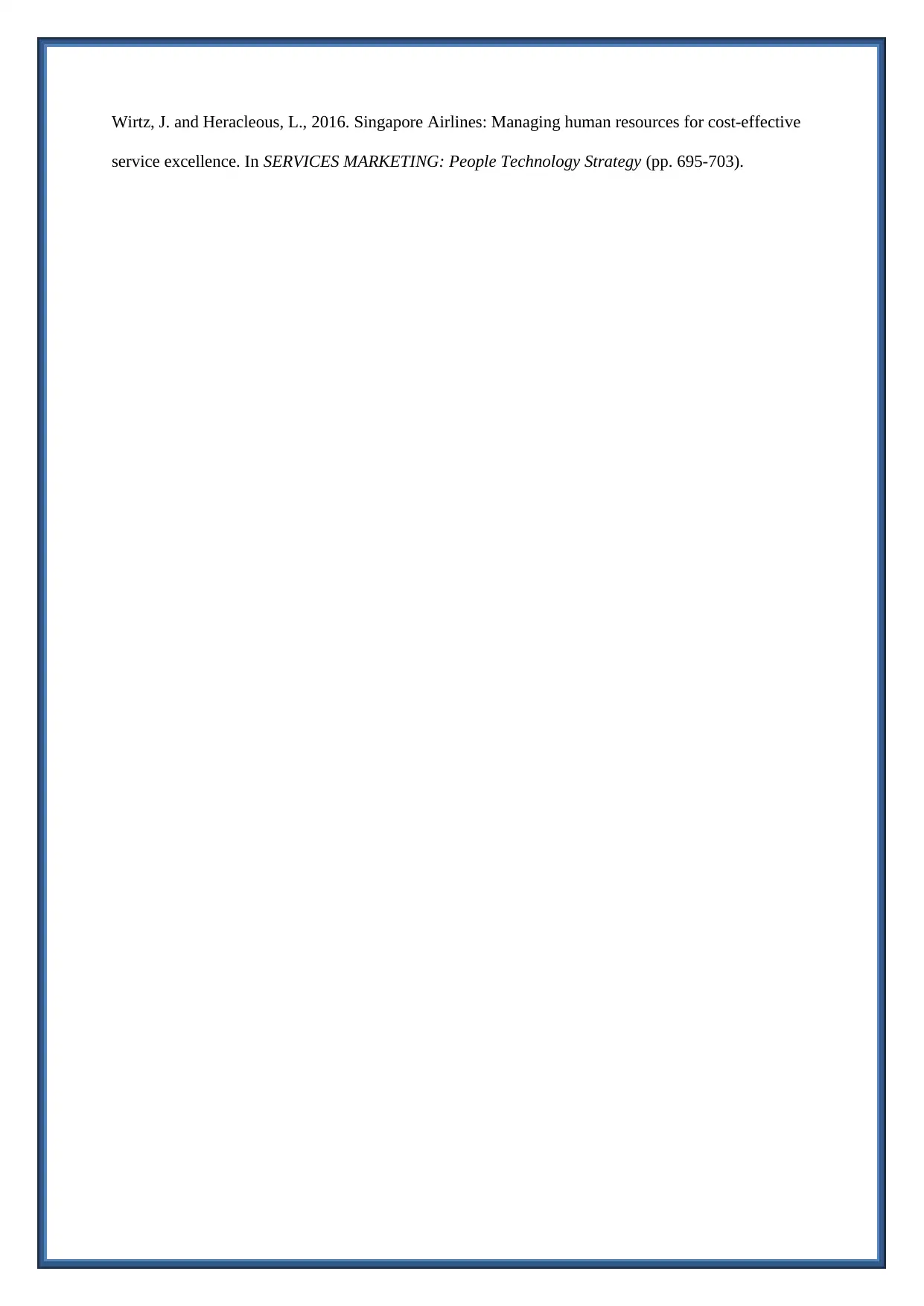
Wirtz, J. and Heracleous, L., 2016. Singapore Airlines: Managing human resources for cost-effective
service excellence. In SERVICES MARKETING: People Technology Strategy (pp. 695-703).
service excellence. In SERVICES MARKETING: People Technology Strategy (pp. 695-703).
1 out of 7
Related Documents
Your All-in-One AI-Powered Toolkit for Academic Success.
+13062052269
info@desklib.com
Available 24*7 on WhatsApp / Email
![[object Object]](/_next/static/media/star-bottom.7253800d.svg)
Unlock your academic potential
Copyright © 2020–2025 A2Z Services. All Rights Reserved. Developed and managed by ZUCOL.



